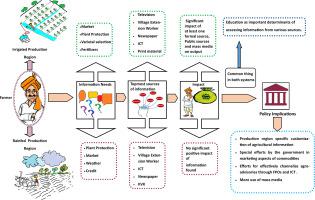Agricultural Systems ( IF 6.1 ) Pub Date : 2021-11-25 , DOI: 10.1016/j.agsy.2021.103317 Vinayak Nikam 1 , Arathy Ashok 1 , Suresh Pal 1

|
CONTEXT
Access to information is crucial in decision making for viable and sustainable farm business. Thus, the farmers need different types of information from various sources to refine existing practices and adopt new technologies for yield and income advantages. Knowledge about farmers' information needs, access and its impact in different production contexts help in improving the effectiveness of extension and advisory services in the country.
OBJECTIVE
This paper examines the farmers' information needs, access to information from different sources and its impact on cotton output and value of output in two different regions having predominantly rainfed and irrigated production contexts.
METHODS
Household level survey data of 644 cotton farmers were collected using multistage sampling from two districts representing distinct production contexts in the Maharashtra state of India. Factors determining the access to information from particular sources were obtained using the Probit model. The impact of access to information was estimated using Inverse Probability Weighted Regression Adjustment (IPWRA).
RESULTS AND CONCLUSIONS
The information needs of the farmers from the two regions were slightly different. In the Jalgaon district with predominantly irrigated cotton production, farmers receiving information from at least one formal source had a significant positive impact on cotton output and the value of output per unit area. While considering each formal information source separately, heterogeneity in impact was observed. Access to information from public sources and mass media had a significant positive impact on cotton output. Mass media sources played a significant role in increasing the value of output per unit area. Despite government and other agencies' efforts and better access to information in predominantly rainfed areas (Yavatmal district), information received by farmers could not produce the desired impact. It necessitates appropriate tailoring of information, specific for these regions; as general information failed to produce much impact.
SIGNIFICANCE
This is a holistic study about information dynamics in agriculture, covering information need to its impact in two different cotton producing regions. The study reflects the heterogeneous impacts of access to agricultural information considering different sources. It suggests the importance of region specific customization of agricultural information and emphasizes more role of public sources in provision of market intelligence. Study advocates efforts to effectively channelize agro-advisories through Farmer Producer Organizations (FPOs) and Information Communications Technology (ICT) sources.
中文翻译:

农民的信息需求、获取及其影响:来自印度马哈拉施特拉邦不同棉花产区的证据
语境
获取信息对于可行和可持续的农场业务的决策至关重要。因此,农民需要来自各种来源的不同类型的信息来改进现有的做法并采用新技术来获得产量和收入优势。了解农民的信息需求、获取方式及其在不同生产环境中的影响有助于提高该国推广和咨询服务的有效性。
客观的
本文考察了农民的信息需求、从不同来源获取信息的途径及其对棉花产量和产量价值的影响,这两个地区主要是雨育和灌溉生产环境。
方法
使用多阶段抽样从代表印度马哈拉施特拉邦不同生产环境的两个地区收集了 644 名棉农的家庭级调查数据。决定从特定来源获取信息的因素是使用 Probit 模型获得的。使用逆概率加权回归调整 (IPWRA) 估计了获取信息的影响。
结果和结论
两地农民的信息需求略有不同。在以灌溉棉花生产为主的 Jalgaon 地区,农民至少从一个正式来源获得信息,对棉花产量和单位面积的产值产生了显着的积极影响。在分别考虑每个正式信息源时,观察到影响的异质性。从公共来源和大众媒体获取信息对棉花产量产生了显着的积极影响。大众传媒资源在增加单位面积产值方面发挥了重要作用。尽管政府和其他机构在以雨养为主的地区(亚瓦特马尔地区)做出了努力并更好地获取信息,但农民收到的信息并不能产生预期的影响。它需要针对这些地区进行适当的信息裁剪;由于一般信息未能产生太大影响。
意义
这是一项关于农业信息动态的整体研究,涵盖信息需求及其在两个不同棉花产区的影响。该研究反映了考虑到不同来源的农业信息获取的异质影响。它表明了农业信息区域特定定制的重要性,并强调了公共资源在提供市场情报方面的更多作用。该研究提倡努力通过农民生产者组织 (FPO) 和信息通信技术 (ICT) 来源有效地引导农业咨询。











































 京公网安备 11010802027423号
京公网安备 11010802027423号